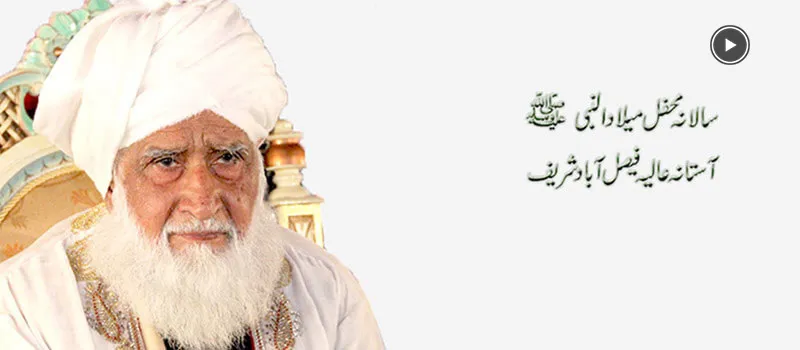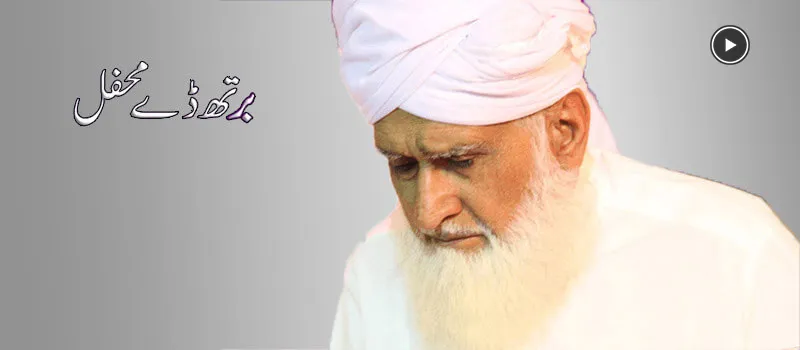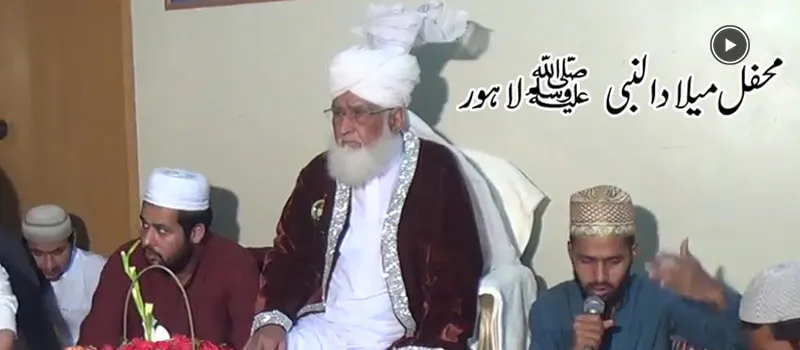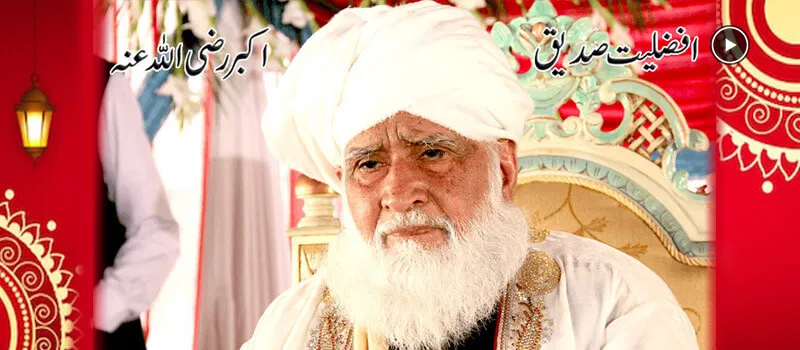HAZRAT KHWAJA’S ANCESTORS
History stands witness to the fact that Islam entered the subcontinent through Auliya-e-Karam (saints, friends of Allah) Hazrat Data Ganj Bakhsh, Hazrat Moeen-ud-Din Chishti. Hazrat Baba Fareed Ganj Shakar, Hazrat Mujaddid Alif Sani to name a few, through their strenuous efforts spread the message of Islam in highly inimical social conditions and depressed economic circumstances. But their ratio of success was amazing. Among such galaxy of Islamic saints stands the towering personality of Ghous al Zama his nobleness Hazrat Khwaja Muhammad Qasim Sadiq.
Generations back the forefathers of the Khwaja migrated from Iran in the pursuit of dissemination of Islamic knowledge and settled down near Rawalpindi. The forefathers of the Khwaja belonged to the ruling Kiyani dynasty of Iran who had widespread political and governmental influences at that time. They could also stay as privileged members of the ruling class like other kith and kin but the ancestors of the Khwaja chose the way of Allah at the expense of saying farewell to ancestral hearth and home. His nobleness Hazrat Khwaja Muhammad Qasim Sadiq was born in the year 1263 Hijri. His childhood is characterized by pleasant nature, tolerance, power of intellect, penetrative insight, commanding looks, tall, handsome and princely personality with all the winsome manners. His way of conversation was always in low but confident-inspiring tone. He talked in commandingly loveable manner befitting the grandeur of a sassanian Iranian prince.
HAZRAT SAHIB’S EDUCATION
He acquired his elementary education at home according to the Muslim traditions. From the very early age of childhood he had established his inquisitive brilliance of mind and thought. For higher studies in Islamic jurisprudence and shariah he underwent long journeys to various centers of Islamic learning at the time. At the early age of twenty he had completed his education in various disciplines of religion. After his education he devoted himself to prayers and preaching the message of Islam. Soon he became famous as a man of great learning. Dozens of truth seekers would sit around him and would listen to his preaching. The light thus started spreading far and wide. His name became known as household name both near and far. This was the glory he attained on the formal side of his education. But still a greater and lasting fame was awaiting him. And that was his spiritual height he conquered during his lifetime.
SPIRITUAL ENHANCEMENT
His Holiness Hazrat Khwaja Muhammada Qasim Sadiq undertook the journey to his spiritual sheikh on foot and received spiritual inspiration from his murshid his nobleness Hazrat Khwaja Nizammuddin Auliya a famous saint of Kashmir. His murshid acquainted his discipline with all the stages of spiritualism at a single glance. And after a short time the Khwaja was bestowed with khilafat and was commanded by his murshid to take his sojourn at Mohra Shareef Murree. At that time Murree was not as it looks today. It was the habitat of savage wildlife like leopards, lions etc.
The Khwaja according to his murshid’s advice undertook a 40 days spiritual ordeal (Chillah) the stone slab on which the Khwaja sat for 40 days (day and night) is preserved even today as a relic at Mohra Shareef along side other relics. Who knew at that time that the fortune was working silently to bring brilliance and world wide fame to Mohra Shareef. The place also became a permanent abode of the Khwaja afterwards. It was there that he spent the rest of his life. Millions of devotees assemble every year at this centre to pay homage to the auspicious soul of his highness the Khwaja of the east Hazrat Peer Muhammad Qasim Sadiq.
PRAYERS
Apart from offering obligatory five times a day prayer the Khwaja would offer one thousand nowafil (Optional Prayer) each night beside other routine prayers. It was his usual practice to hold preaching court (darbar) to impart spiritual education to the devotees. Special stress was laid on faith fortification and on instilling the lesson of tauheed (oneness). It is characteristic of his devotion to prayers that he did not abandon even one when physically indisposed. When he entered his 95th year of life he fell ill. At this beside he called his son Hazrat Khwaja Gareeb Nawaz Peer Muhammad Zahid Khan Sahib who had already attained spiritual heights and conferred his Khilafat on him.
HAZRAT PEER GHOUS AL ZAMA BABA JI SARKAR’S MIRACLES
Remember: the miracles of a saint are all from Allah
In Mohra Shareef we have two urs every year one which is observed in the summer and one in the winter, fifty years before the passing away of Hazrat Baba Ji we only had one urs and that was the one we observe in summer which is observed in respect for Hazrat Sahib’s Shaykh; Hazrat Nizamuddin Auliya of Keya Shareef. Hazrat Sahib started to observe a second urs in the winter time when asked by family why Hazrat Sahib is observing the urs in the winter, Hazrat Sahib replied for time shall tell. Fifty years later the day Hazrat Sahib passed away was the same day he had been observing his own urs for the previous 50 years.
My Shaykh his holiness Dr. Peer Fazeel Ayaz Qasmi relates a miracle of Hazrat Peer Qasim. One day a person with the disease of leprosy came to the darbar to ask Hazrat Qasim to pray for him Hazrat Sahib told him to go to the langar Khana (the area where the food is prepared) and go and knead some dough so the person left to go to the langar khana the person who was in charge of the langar khana told the person who had come to knead the dough as requested by Hazrat Sahib to leave that he would spoil the dough the person returned to the Darbar Hazrat Sahib sent him again to the langar khana this time the person in charge did not stop him after the person had completed kneading the dough after washing his hands he saw that he had been cured.
HAZRAT SAHIB’S KHULAFA
Hazrat Baba Ji Sarkar had over 17 lac mureeds he also had 35,000 khulafa and 750 who were sahib-e-tariqat of whom are some of the following: Hazrat Sahib from Bengali Shareef, Rjoya Shareef, Bagdara Shareef Peer Irani Shah, Pir Narian Shareef Kanara Shareef , Lukhan Shareef, Peer Sahib Kotgullah Shareef, Gamgol Shareef, Tore Shareef, Khalifa Abdul Majeed Sahib (India), Haji Malang Baba, Baba Ghulam Yaseen (Khanewal), Peer Muzzamal Shah Sahib (Sargodha), Peer Vilayat Shah Sahib, Peer Fazal Hussain Shah Sahib (Puran), Hakim Fazal Kareem Qasmi (Sargodah), Moulana Ghulam Rasool Sahib (Nurdi). Peer Sab Sawat Medanak…… and many more.
LAST ADVICE
About two weeks before breathing his last breath while in Isha prayers he summoned members of his family and khulfa to advice them to remain very kind generous and helpful to every one who comes to them. He advised: “Whosoever comes to you should be treated gently, kindly, fatherly no room should be brooked for prejudice envy bias etc…” At the conclusion of his precious advice he took his dastar and conferred on his glory to Aala Hazrat Peer Muhammad Zahid Khan Sahib who is popularly known as Peer Khan Sahib.
His holiness Hazrat Peer Qasim Sadiq Passed away on the 20th November of 1943 leaving behind millions of disciplines and devotees to mourn him. His funeral prayers were offered three times on the day of his demise due to ever swelling number of mourners attending his funeral.
A Spiritual Legacy of Baba Ji Khawaja Muhammad Qasim Sadiq (Razi Allah Anhu)
Introduction to Baba Ji Sarkar (RA)
Hazrat Khawaja Muhammad Qasim Sadiq (RA), also known as Baba Ji Sarkar, was born in 1263 A.H. His ancestors came from Iran and settled in Rawalpindi, Pakistan. Baba Ji was a great spiritual leader, often called Ghaus-e-Zaman or “Spiritual Leader of the Time,” and was admired as the "Spiritual Sun" of the East. His life, which spanned 120 years, played a key role in spreading the teachings of Islam in Asia.
The Spiritual Path and Orders
Baba Ji followed the Naqshbandi, Mujaddidi, and Qasmia Sufi orders. He received his spiritual teachings from His Holiness Khawaja Nizamuddin Aulia of Kahiyan Sharif. While he was given permission to teach in four Sufi orders, Baba Ji mainly focused on the Naqshbandi and Qadri paths.
Early Life and Education
From a young age, Baba Ji was known for his sharp intellect. He studied Islamic teachings at home and traveled far and wide to deepen his knowledge of Islamic law. By the time he was 20, Baba Ji had completed his studies and turned his focus to prayer and teaching others about Islam.
Building a Community in Murree
Baba Ji also built a mosque in Murree, where he served as the Imam. There, he taught children and held regular lectures on various religious topics. His wisdom quickly gained him a following, and people from near and far came to hear his teachings.
A Turning Point: Leaving Wrestling
Before becoming a spiritual leader, Baba Ji was a well-known wrestler, winning many competitions. But after meeting a saint who told him he had a greater purpose, Baba Ji left wrestling and began his spiritual journey.
Spiritual Quest for a Guide
Baba Ji traveled to seek a spiritual guide and met Baba Fazal Shah Kalyami (RA), who instructed him to go to Kashmir to find his true teacher. Following this advice, Baba Ji eventually met his Murshid, His Holiness Ghous-e-Zaman Khawaja Nizamuddin Aulia, in Neelam Valley, Kashmir. After spending time with him, Baba Ji received spiritual authority and was told to settle in Mohra Shareef, Murree.
Settling in Mohra Shareef
When Baba Ji arrived in Mohra Shareef, it was a remote and wild place, filled with dangerous animals. Following the advice of his spiritual guide, Baba Ji spent 40 days in deep spiritual meditation (chillah) on a stone slab, which is still preserved as a relic today. This became the place where Baba Ji spent the rest of his life, and it later became a famous spiritual center.
A Legacy of Spiritual Impact
During his life, Baba Ji brought thousands of non-Muslims to Islam, especially in Kashmir and areas like Kotli. His devotion to prayer was remarkable; every night, he would pray 1,000 nafil (optional) prayers, in addition to the five required prayers. Baba Ji also practiced Zikr (remembrance of Allah) with every step he took, breathing in "Allah" with his right foot and exhaling "Hoo" with his left.
Teachings and Devotion to Prayer
Baba Ji’s gatherings, or Darbar Shareef, were a place where he taught his followers about faith, the Oneness of Allah (Tauheed), and the importance of kindness and generosity. Even when he was unwell, Baba Ji never stopped praying.
The Final Years and Passing
When Baba Ji reached the age of 95, he fell ill. Before his passing, he passed his spiritual authority to his son, Khawaja Pir Muhammad Zahid Khan (RA). Two weeks before his death, Baba Ji shared his final advice with his family and disciples: always treat others with kindness, generosity, and fairness.
The Legacy Lives On
On November 20, 1943, Baba Ji passed away, leaving behind millions of followers who mourned his loss. His funeral prayers were offered three times due to the large number of people who came to pay their respects. Today, millions continue to visit Mohra Shareef to honor Hazrat Khawaja Muhammad Qasim Sadiq (RA), the "Lion of Allah" and Patron Saint of the East.





